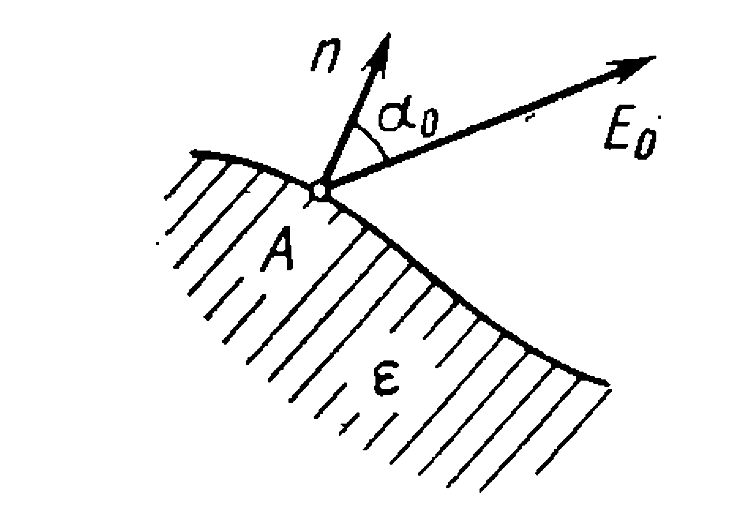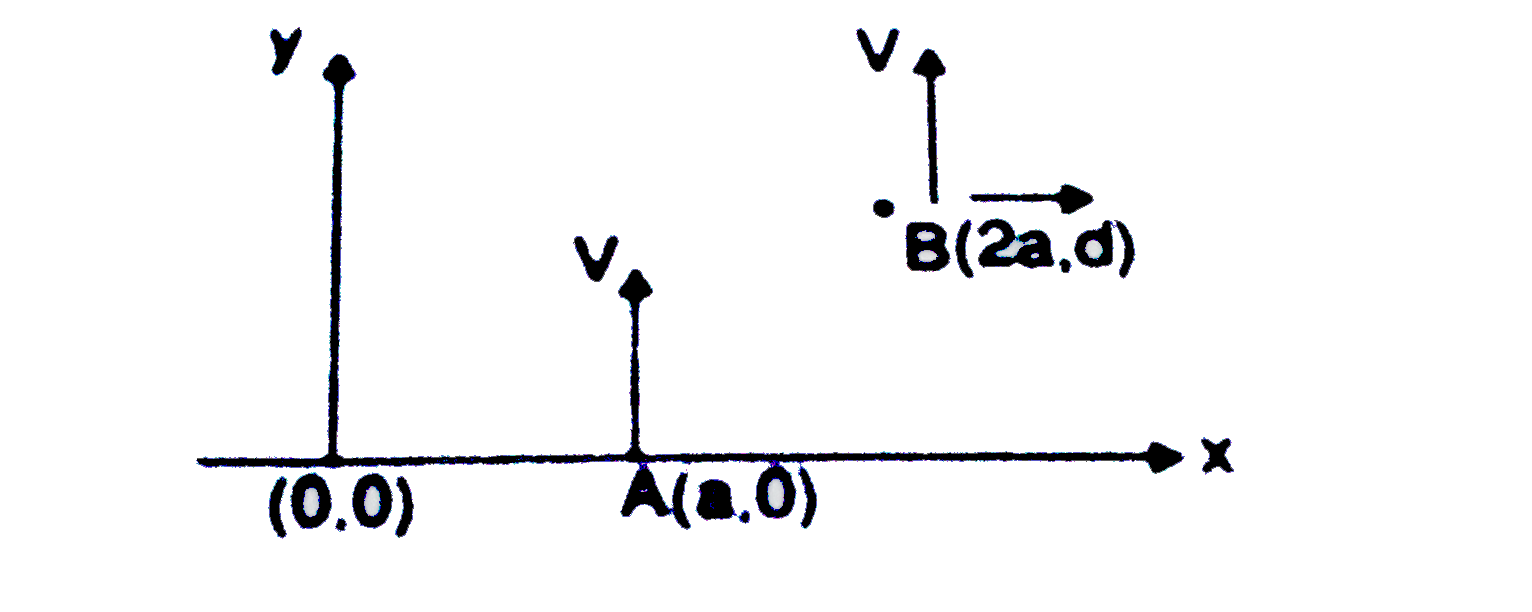Near the point A (Fig) lying on the boundary between glass and vacumm the electric field strength in vacumm is equal to E0=10.0V/m, the angle between the vector E and n, as well as the surface density of the point charges at the point A.

Let the field in the dielectric be →E making an angle α with →n. Then we have the boundary conditions,
E0cosα0=εEcosα and E0sinc0Esinα
So E=E0√sin2α0+1ε2cos2α0 and tanα=εtanα0
In the dielectric the normal component of the induction vector is
Dn=ε0εEn=ε0εEcosα=ε0E0cosα0
σ'=Pn=Dn−ε0εn=(1−1ε)ε0cosα0
σ'=ε−1εε0E0cosα0

Topper's Solved these Questions
- ELECTRODYNAMICSBook:IE IRODOV, LA SENA & SS KROTOVChapter:ELECTRODYNAMICSExercise:Electric Capacitance - Energy Of An Electric Field
Explore 46 Videos
- ELECTRODYNAMICSBook:IE IRODOV, LA SENA & SS KROTOVChapter:ELECTRODYNAMICSExercise:Electric Current
Explore 72 Videos
- ELECTRODYNAMICSBook:IE IRODOV, LA SENA & SS KROTOVChapter:ELECTRODYNAMICSExercise:Motion Of Charged Particle In Magnetic Field
Explore 36 Videos
- ELECTRICITY AND MAGNETISMBook:IE IRODOV, LA SENA & SS KROTOVChapter:ELECTRICITY AND MAGNETISMExercise:All Questions
Explore 6 Videos
- ELECTROMAGNETISMBook:IE IRODOV, LA SENA & SS KROTOVChapter:ELECTROMAGNETISMExercise:All Questions
Explore 24 Videos
Similar Questions
Near the point plane surface of a uniform isotropic dielectric with permittivity ε the electric field strength in vacumm is equal to E0 the vector E0 forming an angle θ with the normal of the dielectric's surface (FIg). Assuming the field to be uniform both inside and outside the dielectric, Find:

(a) the flux of the vector E through a sphere of radius R with centre located at the surface of the dielectric,
(b) the circulation of the vector D around the closed path I' og length l (see fig) whose plane is perpendicular to the surface of the dielectric and parallel to the vector E0.

View SolutionA round current-carrying loop lies in the plane boundary between magnetic and vacumm. The permeability of th emagnetic is equal to μ Find the magnetic induction B at an arbitary point on the axis of the loop if in the absence of th e magnetic the magnetic induction at the same point becomes equal to B0 . Genralize the obtained result to all poins of the field.
View Solution
Knowledge Check
A uniform electric field of strength e exists in a region. An electron (charge -e, mass m) enters a point A with velocity Vˆj. It moves through the electric field & exits at point B. Then :
 A→E=−2amv2ed2ˆi.BRate of work done by the electric field at B is 4ma2v3d3CRate of work by the electric field at A is zero.DVelocity at B is 2avdˆi+vˆj.
A→E=−2amv2ed2ˆi.BRate of work done by the electric field at B is 4ma2v3d3CRate of work by the electric field at A is zero.DVelocity at B is 2avdˆi+vˆj.If the electric field is given by →E=(100x2)i the potential difference between points x=10m and x=20m in volts is
A−5B5C−10D10The electric field due to point charged at a distance R form it is E. if the same charge is placed on a metallic sphere of Radius R, the electric field on the surface of the sphere will be
AzeroB10 VCmore thanDnone of these
A conductor with respectivity ρ bounds on a dielectric with permittivity ε. At a certain point A at the conductor's surface the electric displacement equals D the vector D being directed away from the conductor and forming an angle α with the normal of the surface. Find the surface density of charges on the conductor at the point A and the current density in the conductor in the vicinitity of the same point.
View SolutionA point charge q si located on the plane dividing vacumm and infinite uniform istropic dielectric with permittivity eposilon. Find the moduli of the vectors D and E as well as the potentail φ as funtions of distance r from the charge q.
View Solution[" The electric field strength at a "],[" distance r from a charge q is E."],[" What will be electric field strength if "],[" the distance of the observation "],[" point is increased to "2" r? "]
View SolutionA thin straight rod of length 2a carrying a uniformly distributed charge q is located in vacumm. Find the magnitude of the electric field strength as a function of the distatance r from the rod's centre along the streaight line
(a) perpendicular to the rod and passing through its centre ,
(b) coinciding with the rod's direction (at the point lying outside the rod).
View SolutionFrom a point charge, there is a fixed point A. At a, there is an electric field of 500 V/m and potential difference of 3000 V. Distance between point charge and A will be
View Solution

